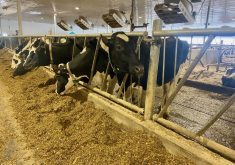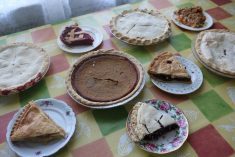“Meet you for coffee in 10.”
This is a phrase and a habit my daughter, Katherine, has picked up at school this year. Meeting a group of friends to retreat off campus to an intimate specialty coffee shop gives a welcome change to their classes, assignments and study routine. Even reading a textbook becomes a bit more enjoyable while sipping a coffee in the corner of a shop.
Coffee has become the social beverage of choice for many. Intimate coffee cafés, noisy coffee bars or coffee lounges in bookstores, airports or on a street corner now offer a vast array of coffee variations.
Read Also

Accurate accounting, inventory records are important
Maintaining detailed accounting and inventory records is not just a best practice; it’s a critical component of financial health, operational efficiency and compliance with programs like AgriStability.
According to the Coffee Association of Canada’s website, www.
coffeeassoc.com, Canadians drink more than 15 billion cups of coffee a year. Of this, 69 percent is drunk at home or in someone else’s home, while 13 percent of coffee is consumed at work or school and 12 percent in a restaurant.
A friend of mine, who is a coffee lover recommended I read the book Cappuccino Cocktails Specialty Coffee Recipes and ‘A-Whole-Latte’ more! by Susan M. Zimmer of Calgary.
Zimmer has 15 years of experience in the coffee industry and shares her knowledge along with java jokes and coffee quotes. This really is a fun book to read as well as being full of recipes for making gourmet coffees at home.
Espresso is the foundation of many specialty coffees. There is a fine art to making it, as Zimmer explains in her definition: “A true espresso is produced when 11/2 ounces (45 mL) of filtered water at a temperature of 195 F (90 C), passes through 1/4-1/3 ounce (seven to nine g) of a finely ground, quality espresso coffee, and is forced through the fine coffee grounds at nine atmospheric pressure (approximately 132 pounds or 60 kilograms per sq. inch (2.5 cm2), with the water being in direct contact with the coffee for approximately 25 seconds.
“A quality espresso, when consumed, should leave a pleasant, not bitter, aftertaste lingering on the palate for approximately 10 minutes, curling into an almost nutty flavour.
“The ‘crema’ or ‘dark golden cream’ crowned on top of the finished espresso coffee is formed when the emulsified coffee oils are released (due to the high pressure on the grounds) and it comes into contact with the atmosphere’s oxygen. In its buoyant perfection, the crema floats on top of the espresso coffee.”
To create the aroma, body and crema characteristics of a true espresso, a coffeemaker that will produce the high pressure and hot-but-not boiling water are needed. The pump, piston-driven and electric steam-powered machines come in expensive home and commercial versions. The Moka-style stove top and the Neapolitan flip-drip pots are less sophisticated but more economical methods for home-brewed espresso.
Milk and cream are essential for the creation of frothy cappuccinos and steamy lattes. Steamed milk has been heated to just under the boiling point, usually by the injection of steam or by a heat source. Frothed or foamed milk has been both heated and aerated by injecting a wand of hot steam at the surface of the milk. This creates a microfoam of tiny air bubbles, giving the milk an ideal consistency of light whipped cream.
Classic cappuccino is made with one-third espresso, one-third steamed milk and one-third foamed milk. Café latte is made with one part espresso and two or three parts steamed, not foamed, milk.
Whisked or frothed milk
Use this easy at-home method for making frothed milk for your own cappuccinos.
7 ounces 2% or homogenized cold milk 225 mL
Pour the cold milk into a saucepan. Set it on the stove over medium heat and gently warm the milk. Whisk the milk in the saucepan constantly and briskly while heating until it develops into a fluffy froth and almost doubles in volume. A hand mixer can be used for quicker results.
When making espresso beverage, ensure the milk used for frothing is very cold and the espresso coffee is very hot. To assemble the cappuccino or latte, pour the fluffy milk froth onto the waiting hot espresso coffee.
What’s inside
On average, a purchased iced cappuccino contains 12 grams of mostly saturated “hard” fat, nine teaspoons (45 mL) of sugar and 100 mg of caffeine in a small 10 ounce (340 mL) glass. This is the same amount of caffeine as a cup of coffee and more saturated fat than what is in a McDonalds Big Mac.
Hard fat is a concern because it is thought to increase blood cholesterol levels and increase the risk of heart disease.
By making an iced cappuccino at home, you can reduce the amount of fat by using lower fat milk rather than cream, and you can also reduce the amount of sugar or use a sugar substitute.
Here is Zimmer’s recipe for iced cappuccino.
Iced cappuccino
Start preparing this the day before you wish to serve it.
1 cup espresso (or 250 mL
strong coffee)
6 ounces cold milk 170 mL
2 tablespoons sugar 30 mL
2 tablespoons coffee 30 mL
syrup (below)
The first day, pour the coffee into two ice cube trays and freeze.
Prior to serving, place coffee ice cubes, milk, sugar and coffee syrup in a blender. Blend until smooth. Pour into chilled glasses and serve immediately. Serves two.
Coffee syrup
This versatile syrup can be used to make iced coffees or can be poured over desserts and ice cream.
2 cups hot, fresh 500 mL
espresso
(or strong coffee)
11/3 cups sugar 325 mL
1 vanilla bean, split
lengthwise
1/3 cup dark roast 75 mL
coffee beans (slightly cracked)
1/8 teaspoon salt 0.5 mL
Combine the coffee, sugar, vanilla bean, coffee beans and salt in a medium saucepan. Place over low heat, stirring frequently, until sugar is dissolved. Boil over medium-high heat, without stirring, for about four minutes, or until thick and syrupy. Remove the saucepan from the heat and cool completely.
Strain the coffee mixture through a fine sieve into a small bowl.
Discard the coffee beans and set the vanilla bean aside for another use (see below).
Put the syrup in a covered container and chill until ready to use. Yields about one cup (250 mL).
Vanilla sugar tip
Wash and dry the vanilla bean that was used to make the coffee syrup, then push it into the middle of a six-cup (1.5 L) container filled with granulated sugar. Set aside, covered, for two weeks. This vanilla sugar has a delicate aroma and flavour, and can be used for baking or sweetening anything.
To order Cappuccino Cocktails Specialty Coffee Recipes and ‘A-Whole-Latte’ more! by Susan M. Zimmer, call her toll-free 877-888-8898 or order on line at www.cappuccino cocktails.com. Each book ordered also includes a CD on which executive chef Hegnauer of The Banff Centre, demonstrates step-by-step how to make a basic cappuccino/latte without a machine.
Chicken wings
Dear TEAM: I would like to get a tried and true recipe for chicken wings that will please everyone for a large gathering. – E. R., North Battleford, Sask.
Dear E. R.:
Chicken wings are always a favourite, especially with the guys and teens who want something with a little meat. This is a honey chicken wings recipe from my sister-in-law Diane MacDonald of Regina. Her family loves it and it’s a big hit at our place as well. The recipe can easily be increased to serve a crowd.
3 pounds small 1.5 kg
chicken wings
1/2 cup brown sugar 125 mL
3 tablespoons 45 mL
cornstarch
1/2 teaspoon salt 2 mL
1/2 teaspoon ground 2 mL
ginger
1/4 teaspoon pepper 1 mL
2/3 cup water 150 mL
1/3 cup lemon juice 75 mL
1/4 cup soy sauce 50 mL
Cut wings in half at the joints. Discard wing tips. Place on broiler rack and bake at 400 F (200 C) for 15 minutes. Turn and bake an additional 15 minutes.
Mix the sugar, cornstarch, salt, ginger and pepper in a saucepan. Add the water, lemon juice and soy sauce. Cook, stirring constantly, over medium heat until mixture thickens. Boil two minutes.
Brush over wings and continue baking at 400 F (200 C) for about 35 minutes. During the baking brush the sauce mixture over the wings frequently.
Crock pot method
The wings can be browned in the oven for 45 minutes, turning after 20 minutes. Then place the wings in a crock pot, cover with the sauce and cook for two to three hours on medium.
For something with a little more zing, try this recipe.
Oriental chicken wings
1 garlic clove, minced
1 tablespoon oil 15 mL
1 teaspoon ginger 5 mL
2 tablespoons ketchup 30 mL
1/4 cup honey 50 mL
3 tablespoons orange 45 mL
juice
2 tablespoons lemon 30 mL
juice
1 tablespoon soy sauce 15 mL
2 pounds chicken 1 kg
wings (about 12 wings)
Preheat oven to 375 F (190 C).
Sauté garlic in oil. Add all other ingredients, except wings; simmer on low for 15 minutes.
Remove wing tips, discard or save for stock, cut wings into two parts and put in a large glass dish.
Pour sauce over the wings and marinate in refrigerator at least two hours or overnight, stirring occasionally.
Place chicken on foil-lined baking sheet. Brush with marinade.
Bake for 40 minutes, basting occasionally. Remove from oven; place on a platter; serve immediately. Serves 10 -12.
Source: A Taste of Christmas by Jacquie Schmit, Eileen Mandryk and Jo Wuth.
Betty Ann Deobald is a home economist from Rosetown, Sask., and one of four columnists comprising Team Resources. Send correspondence in care of this newspaper, Box 2500, Saskatoon, Sask., S7K 2C4 or contact them at team@producer.com.














